Congee
In the middle of last week, my husband, who is generally the kind of person who will work whenever he has a chance, changed his tune and came home early. I was surprised to see him sitting in the dim quiet living room when the baby and I got home, with a plastic sack in his hand. He was waiting for us to come in on him, sitting in the dark. He does things like this from time to time. It's part of living with a scientist. Although he communicates in very direct and explicit language to convey the results of his research, his regular communication to me is less direct. On rare occasions, he does things like sit in the dark, signals that I have come to understand like a code over the years of our marriage. The baby was caught up in the moment of seeing papa unexpectedly and threw himself onto his lap. "It's a stomach virus." he said, and handed me the sack, full of medicine fresh from the pharmacy. I knew that his waiting for us like that meant that he needed to be babied himself. After settling him on the sofa with a blanket and fixing him a cup of herbal tea, I went to the kitchen to get supper on.
Congee came to mind as the best choice for him. It is one of those dishes I have carried to France with me, collected during my years in China. It always brings up complex emotions, because it is a kind of genre food, one of those things that in the lives of the people in China I knew and loved, carried symbol and meaning. You know, it's typically a breakfast food in that country. But beyond that, when you start delving into soul searching with a Chinese person, you'll probably find congee there in very tender places. In a very intense time in my life, congee sprang up a lot. The little pickles and preserves people add to the savory ones came in different shapes and consistencies. I am not Chinese, but my senses awakened in China. I speak Mandarin Chinese. I fell in love in Beijing, a story that's still simmering, trying to find a way to organize itself. That story did not have a happy ending, and I am not sure that there was a life lesson. I should not be afraid of congee, although, like I said, when it pops into my head in this innocent way, something mild and nourishing to soothe the love of my life, I can't help but take a breath, with a start.
On the way to a distant poor province to visit Haibo's parents, we shared an old sedan from a place near Shanghai, rented by his sister and her Hong Kong sugar daddy. The sedan bounced like a boat above the pitted road. The landscape was empty.
They are in the front seat. She reaches up, pretending to adjust the rear view mirror, and turns her hand to and fro to make her diamond sparkle. Hai Bo receives this like a signal. He and I had a quarrel the night before. We will never know each others' secret codes. He has bought a can of congee to eat for breakfast and he offers me a taste. We are bouncing against light blue velour, my sight is drawn to the blemishes, a couple of gum stains and the occasional cigarette burn. I can feel the springs. I take a sip from the can. It is sweet, light, and silky. Nothing like this moment, but very much like it too. He smiles.
I prefer my congee on the savory side. This recipe is the congee Ayi used to prepare for me from time to time in Beijing. There is no secret or technique. It just takes awhile. It is very soothing and filling, but easy on the stomach, so if you're feeling a little under the weather, it can be just the thing.
Basic Congee
2 tablespoons plump white rice
4 cups of water
2 1/2 teaspoons light soy sauce
1 thin slice of ginger
1 teaspoon sesame oil
1/4 teaspoon salt
1 tree ear mushroom, soaked and cut into slivers
3 scallions, chopped
Pickles of choice for garnish
Rinse the rice until the water flows clean. Soak it in enough warm water to cover it for awhile, 15 to 20 minutes. Add the rice and its soaking liquid to the 4 cups water that you've brought to a boil. Lower the heat and simmer it for an hour or two, until the grains dissolve completely. Stir every 10 to 15 minutes to keep it circulating. It should form a gruel. At this point, add the remaining ingredients except for the scallions and pickles, which you can add to the individual bowls just before serving. Simmer, stirring occasionally, for another 20 minutes.
A more rich variation on this recipe is to use unsalted chicken stock in place of the water and add lean chicken meat cut with the grain into very thin slivers at the very end of cooking.
Congee came to mind as the best choice for him. It is one of those dishes I have carried to France with me, collected during my years in China. It always brings up complex emotions, because it is a kind of genre food, one of those things that in the lives of the people in China I knew and loved, carried symbol and meaning. You know, it's typically a breakfast food in that country. But beyond that, when you start delving into soul searching with a Chinese person, you'll probably find congee there in very tender places. In a very intense time in my life, congee sprang up a lot. The little pickles and preserves people add to the savory ones came in different shapes and consistencies. I am not Chinese, but my senses awakened in China. I speak Mandarin Chinese. I fell in love in Beijing, a story that's still simmering, trying to find a way to organize itself. That story did not have a happy ending, and I am not sure that there was a life lesson. I should not be afraid of congee, although, like I said, when it pops into my head in this innocent way, something mild and nourishing to soothe the love of my life, I can't help but take a breath, with a start.
On the way to a distant poor province to visit Haibo's parents, we shared an old sedan from a place near Shanghai, rented by his sister and her Hong Kong sugar daddy. The sedan bounced like a boat above the pitted road. The landscape was empty.
They are in the front seat. She reaches up, pretending to adjust the rear view mirror, and turns her hand to and fro to make her diamond sparkle. Hai Bo receives this like a signal. He and I had a quarrel the night before. We will never know each others' secret codes. He has bought a can of congee to eat for breakfast and he offers me a taste. We are bouncing against light blue velour, my sight is drawn to the blemishes, a couple of gum stains and the occasional cigarette burn. I can feel the springs. I take a sip from the can. It is sweet, light, and silky. Nothing like this moment, but very much like it too. He smiles.
I prefer my congee on the savory side. This recipe is the congee Ayi used to prepare for me from time to time in Beijing. There is no secret or technique. It just takes awhile. It is very soothing and filling, but easy on the stomach, so if you're feeling a little under the weather, it can be just the thing.
Basic Congee
2 tablespoons plump white rice
4 cups of water
2 1/2 teaspoons light soy sauce
1 thin slice of ginger
1 teaspoon sesame oil
1/4 teaspoon salt
1 tree ear mushroom, soaked and cut into slivers
3 scallions, chopped
Pickles of choice for garnish
Rinse the rice until the water flows clean. Soak it in enough warm water to cover it for awhile, 15 to 20 minutes. Add the rice and its soaking liquid to the 4 cups water that you've brought to a boil. Lower the heat and simmer it for an hour or two, until the grains dissolve completely. Stir every 10 to 15 minutes to keep it circulating. It should form a gruel. At this point, add the remaining ingredients except for the scallions and pickles, which you can add to the individual bowls just before serving. Simmer, stirring occasionally, for another 20 minutes.
A more rich variation on this recipe is to use unsalted chicken stock in place of the water and add lean chicken meat cut with the grain into very thin slivers at the very end of cooking.
Labels: Printemps 2010










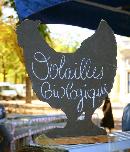
















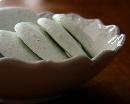








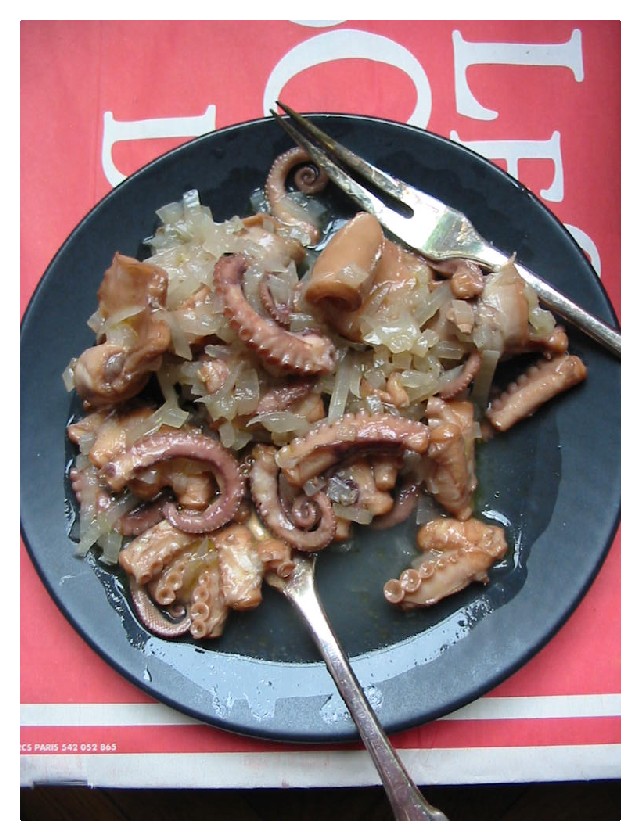


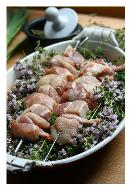












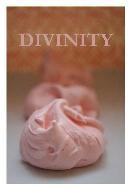
11 Comments:
I've never tasted the silk of congee, but I bounced along in that car---it was hot and they were smoking.
Very evocative, Lucy, as always.
Thanks, Rachel.
Great writing Lucy. I think one of the best I've read.
I love congee. When I have a bowl in front of me, I take a brief journey back in time, to my childhood.
It's magical.
Your recipe is a new method that I must try sometime. I'll put it on my "to do" list.
I'm glad you said that, Stash, because I was going to delete this post. But now I won't.
A beautiful haunting glimpse into a most amazing story...
Lovely post Lucy. My favorite blogposts have that really difficult to achieve, delicate balance between the personal life and the public display of it. In that way, this post is exemplary.
Greetings from Colorado! I have just discovered your blog and am awestruck by your thoughtful writing, beautiful photos, and recipes that make me sigh.
I have not explored your archives yet, so perhaps this is something your regular readers already know, but since you mention a baby here: will you be raising your child(?) bilingually or trilingually (I see that you speak Mandarin as well)? If so, I'd like to invite you to visit my blog about raising kids with more than one language. Would you at some point consider letting me profile your family on my blog? I have a questionnaire that I distribute to bilingual parents, and I'm particularly interested in kids who speak English and French (as my son is poised to do).
Here's a recent example: http://babybilingual.blogspot.com/2010/03/profile-thws-non-native-francophone.html
Please email me at babybilingual (at) gmail (dot) com if you would like to participate. Many thanks for sharing your blog with us!
Is this two cups of rice? two tablespoons seems a little to little??
No, anon, it's 2 tablespoons. The rice basically disintegrates into the water and forms a kind of gelatinous greul. Throughout the long simmer, the liquid dissolves and it thickens. At the end, you can add meat and serve it with pickles.
Congee is a warm blanket with a satin edge curled up against my cheek. My Chineese past, too, has some unresolved sharp edges, but even in that context congee appears as a soft and creamy comfort. It is the perfect thing for a tender stomach in need of care and attention, even when it is the tummy of a later and longer love. Thank you for the recipie Lu.
I studied up on congee this mid-year when reaching (what many would consider) a milestone age after I decided to stop ravaging my body for longevity sake. Saved a few recipes - but haven't cooked any to date.
And lo and behold you can buy it in a can! I would prefer the more rich version with chicken if I was feeling ill. We all know how comforting a warm bowl of chicken soup is when our system isn't 100%.
Post a Comment
<< Home